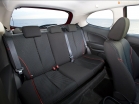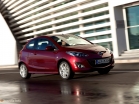Mazda 2 test drive since 2011 hatchback
Battle of Sports Small Cars: Mazda Demio Sport vs Honda Fit RS
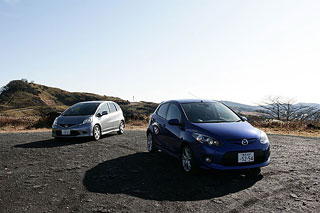 New cars of the Class Class: Sports Categories Models are connected to the fight
New cars of the Class Class: Sports Categories Models are connected to the fight The results of Japanese compact cars in 2007 convincingly indicate that two Honda Fit and Mazda Demio cars still hold leadership in this area. But here's what it is curious to note: if before both cars tried to overcome each other and attract as many buyers as possible to their side, mainly due to the spacious salon (and this, I must say, has succeeded), now the methods of struggle for the place under the place under the place The sun began to vary somewhat.
It has been repeatedly written that when working on a new generation car, the developers decided not to make any significant changes to the usual appearance (they are not looking for good from good, so or?). In other words, outwardly the new FIT seems almost not changed, its wheelbase has only increased, and the front strings of the body turned out to be slightly moved forward to visually expand the salon even more, and at the same time provide the driver with the best review. So, as you can see, the developers of the car of the new Fit remained in their previous positions, making the main bet on the maximum increase in the cubacy (real and visual) of the already non -cramped salon. Naturally, in connection with this they had to take a number of additional measures: to increase the hardness of the body, change the position of the axis of swinging the lower levers of the front suspension with the corresponding change in the shoulder of the rear shock absorbers. All these measures are purely technical in nature, but thanks to them the car significantly added in terms of dynamics and comfort. Comfort and quality, how would I briefly determine the main
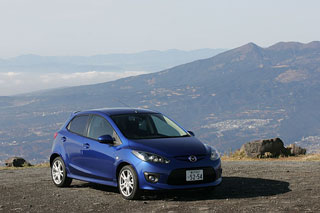 features of a new generation FIT.
features of a new generation FIT. But what about his opponent Mazda Demio? It should be admitted: this time, the creators of this car decided to move away from the previous tactics, the essence of which, as I already noted, was defined as a compact body + not in size a spacious salon. Instead, a course for maximum compactness was taken + minimum weight of the machine. And what happened in the end? Compared to Demio of the previous model, a new machine has become easier to be 100 kg, which, you see, is completely a lot. Of course, to some extent, this is due to a decrease in the size of the machine both in length and in height. But the main thing, apparently, is not in this, but in the fact that the designers made significant adjustments to the body design, removing all the extra and thereby reducing the amount and weight of the material. In the same way, they did with the suspension, reducing the size of the parts and, where possible, their mass, as well as simplifying its design. Here, in fact, due to which such a large gain in weight was received.
Interestingly, it can grunt a different ill -wisher, how it happened that the developers suddenly opened their eyes, and they found extra nodes and details in their own brainchild?. Yes, the whole thing is that, in a sense, the Demio of the previous generation was not different in size with a hard body, and the details used in it were far from always required to make a margin of strength as previously done. In the vocabulary of car technologists there is such a term as optimization. And what is it, if not a revision and recalculation of previously made, taking into account newly discovered circumstances? By these circumstances, I mean both newly emerging materials and the developed technologies. So, with regard to technology, I think, in this regard, the new Demio really deserves a higher rating than its opponent. And if so, then all doubts can be advised not to worry a new car no less durable than the old one.
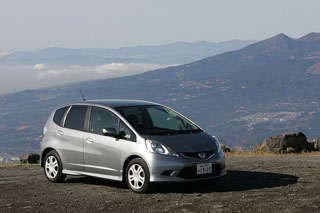 In a word, the confrontation of two competitors Fit and Demio did not weaken at all in 2007, despite the fact that both model rows were completely updated. But what is the most curious of everything, and what we would like to draw the attention of our readers, is the appearance of models in both ranks with a clearly expressed sports orientation. That is, we can rightfully say that the competition of FIT against Demio is now flared up in a new, purely sports direction. The FIT lineup in this duel is represented by the FIT series RS (experts probably know that this abbreviation was borrowed from the Honda Civic automobile family). As for the DEMIO lineup, its sports model is designated as Sport, which, however, is characteristic of all sports machines of the Mazda brand, which are made on the basis of front -wheel drive models with the front engine (FF, if you use English reduction). About the features of these competing sports cars among themselves will be further speech.
In a word, the confrontation of two competitors Fit and Demio did not weaken at all in 2007, despite the fact that both model rows were completely updated. But what is the most curious of everything, and what we would like to draw the attention of our readers, is the appearance of models in both ranks with a clearly expressed sports orientation. That is, we can rightfully say that the competition of FIT against Demio is now flared up in a new, purely sports direction. The FIT lineup in this duel is represented by the FIT series RS (experts probably know that this abbreviation was borrowed from the Honda Civic automobile family). As for the DEMIO lineup, its sports model is designated as Sport, which, however, is characteristic of all sports machines of the Mazda brand, which are made on the basis of front -wheel drive models with the front engine (FF, if you use English reduction). About the features of these competing sports cars among themselves will be further speech. 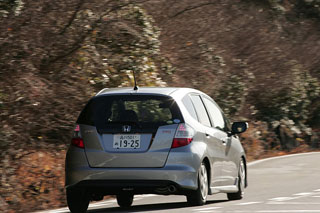 Sports and basic models: what is the similarity and what are the differences?
Sports and basic models: what is the similarity and what are the differences? To date, it has been so that the main distinguishing feature of the sports variety of the Fit car is the class of its engine. Look: a 1.5-liter engine can be found exclusively on a Fit RS car, and on the other hand, there is not one that could be classified as a sport among machines equipped with an engine of 1.3 liters. Well, but how to distinguish the RS car from the basic FIT model without looking under the hood? To do this, you should know that the first has its own front grill, its bumers, both front and rear. Plus, he has a slightly different design than the usual fit, and, finally, another shape of the rear lights. And yet, if you look at the equipment, you can decide on the presence or absence of a VSA exchange rate stability system: this system can only be placed on the FIT RS car, however, if it is monopoly with a drive on the front wheels.
If I touched the equipment, it will not be superfluous to remind you that among the machines of the FIT lineup sold in the domestic Japanese market, only the RS model can be produced with a 5-speed manual switching box. True, this time I got a car not with a box, but with a unavailable CVT variator, which provides for a 7-speed manual switching mode. But I know that RS with a manual box and RS with CVT has, in addition to a transmission, a number of differences. So, RS 5MT is equipped with a 16-inch rubber with aluminum discs of the wheels of special design, and plus the rear wheels are equipped with disc brakes. Then, he must have a VSA system, in front of the headlights of the discharge type, and inside the steering wheel, covered with genuine leather. The same equipment and finishing can stand on a Fit RS car with a vast transmission, the only difference is that if in the first case everything is put in a general manner, then in the second only in the order of the option. That is why my car, although it was equipped with a VSA system, turned out, however, on ordinary wheels with a diameter of 15 inches, which are no different from the wheels of the usual 1.3-liter FIT model of the most expensive category.
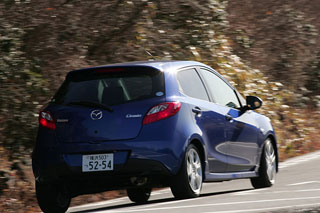 Exactly the same choice is a 5-speed manual box or a stranded CVT variator, there is also customers of the Mazda Demio Sport sports model. Moreover, among all DEMIO cars equipped with a stray transmission, only Demio Sport has a 7-speed manual switching mode. The conclusion suggests itself: the developers initially sought to make their car analogue Fit RS. The external differences between Demio Sport from the base model include the front and rear bums, as well as the rear spoiler. All these details were made in a sports manner according to a special sketch, just like in the case of Fit RS. True, in fairness it is worth noting that the Demio Sport rear spoiler is not something special inherent in this model. The fact is that almost such a spoiler is available on a DEMIO model 13S with a 1.3 -liter engine. But 16-inch tires stretched on aluminum discs is just found only in Demio Sport. In addition, the tires themselves, the size of 195/45 R16 W, is quite expensive, but what you can’t do for the sake of sports! And here's another thing: it has already been repeatedly noted, but I still repeat that only the Demio Sport body has additional stiffness, which connects the place of attachment of the upper end of the front suspension rack with the rear wall of the motor compartment. It is interesting, however, to note that DEMIO’s body body body bodies are also strengthened in this way, and this is not done selectively, but without fail, regardless of the model or category.
Exactly the same choice is a 5-speed manual box or a stranded CVT variator, there is also customers of the Mazda Demio Sport sports model. Moreover, among all DEMIO cars equipped with a stray transmission, only Demio Sport has a 7-speed manual switching mode. The conclusion suggests itself: the developers initially sought to make their car analogue Fit RS. The external differences between Demio Sport from the base model include the front and rear bums, as well as the rear spoiler. All these details were made in a sports manner according to a special sketch, just like in the case of Fit RS. True, in fairness it is worth noting that the Demio Sport rear spoiler is not something special inherent in this model. The fact is that almost such a spoiler is available on a DEMIO model 13S with a 1.3 -liter engine. But 16-inch tires stretched on aluminum discs is just found only in Demio Sport. In addition, the tires themselves, the size of 195/45 R16 W, is quite expensive, but what you can’t do for the sake of sports! And here's another thing: it has already been repeatedly noted, but I still repeat that only the Demio Sport body has additional stiffness, which connects the place of attachment of the upper end of the front suspension rack with the rear wall of the motor compartment. It is interesting, however, to note that DEMIO’s body body body bodies are also strengthened in this way, and this is not done selectively, but without fail, regardless of the model or category. What are the impressions of driving on one and the other car?
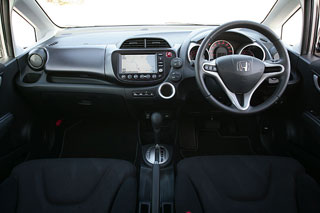 I would formulate a brief answer to this question: driving Fit RS is one thing, and Demio Sport driving is completely different. To what extent this conclusion is determined by the technical features of the machines, and in what result of subjective perception, I will not judge, I will say only one thing: without getting behind the wheel, as they say, on the eye, I have already decided that on the move Demio Sport is simply obliged to be easy . This assumption was, as it were, the starting point, and then, when I also drove off by Fit RS, I said to myself: so if the demio is light (and I already decided for myself that it was light) and frisky, then against its background Fit seems to be Solid, one might even say, heavy. In fact, if you compare the passport data of both cars, it really turns out that there is a fairly large weight difference of 70 kg between the cars (it is natural that Demio Sport is easier and Fit RS is heavier). At the same time, I believe that the weight difference was not so much striking if the developers of Demio Sport did not seek to supplement this, so to speak, design lightness. By technical means, in this case, I mean, firstly, a low center of gravity, and secondly, the nature of the steering. Do not think that it’s easy for me the same thing as a powerful traction. No, as for the subjective sense of traction, in this regard, I would like to give preference to the Fit RS car, despite the fact that it is harder. The fact is that the weight is weighty, but it is also important that the transmission of this machine is different than Demio Sport, gear rates. Hence the feeling that Fit is pulling better. And where Demio Sport has to be pushed, moving on to manual control of the transmission, the second one, you only need to put pressure on the gas pedal, immediately understands what they want from it and, without waiting for a manual poke with his hand, goes into acceleration.
I would formulate a brief answer to this question: driving Fit RS is one thing, and Demio Sport driving is completely different. To what extent this conclusion is determined by the technical features of the machines, and in what result of subjective perception, I will not judge, I will say only one thing: without getting behind the wheel, as they say, on the eye, I have already decided that on the move Demio Sport is simply obliged to be easy . This assumption was, as it were, the starting point, and then, when I also drove off by Fit RS, I said to myself: so if the demio is light (and I already decided for myself that it was light) and frisky, then against its background Fit seems to be Solid, one might even say, heavy. In fact, if you compare the passport data of both cars, it really turns out that there is a fairly large weight difference of 70 kg between the cars (it is natural that Demio Sport is easier and Fit RS is heavier). At the same time, I believe that the weight difference was not so much striking if the developers of Demio Sport did not seek to supplement this, so to speak, design lightness. By technical means, in this case, I mean, firstly, a low center of gravity, and secondly, the nature of the steering. Do not think that it’s easy for me the same thing as a powerful traction. No, as for the subjective sense of traction, in this regard, I would like to give preference to the Fit RS car, despite the fact that it is harder. The fact is that the weight is weighty, but it is also important that the transmission of this machine is different than Demio Sport, gear rates. Hence the feeling that Fit is pulling better. And where Demio Sport has to be pushed, moving on to manual control of the transmission, the second one, you only need to put pressure on the gas pedal, immediately understands what they want from it and, without waiting for a manual poke with his hand, goes into acceleration. 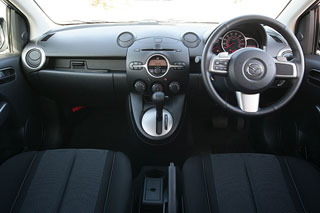 As soon as I was sitting at the wheel of Demio Sport, to budge, and I immediately felt that the body really acquired additional rigidity. He definitely vibrated not like the body of the base model, in this regard, he clearly added. And it doesn’t matter that when the wheels ran into the uneven road surface, they jumped more strongly, the main thing is that only a smooth swaying was felt in the cabin, nothing more. But what about Fit? His suspension turned out to be quite stiff (and how else, it is still a series of RS!), Wheel of moderate wheels (15 inches size, Yokohama S71 S71 Tires). It is true, however, to say that the car can turn too cool, but there is nothing to be done here. But feel what a supply of stability his chassis has! Yes, at least the same back of the car, because it does not scour at all from side to side, as if glowed. The steering acted quite accurately, which, in general, is surprising, taking into account what size the car has a wheel, and even when it is necessary, as they say, to top it, the machine works out the command quite confidently. The body itself, and, above all, its bottom has amazing rigidity. In a word, what can you say Fit RS in terms of body design and on its behavior on the move really gives the impression of a decent machine.
As soon as I was sitting at the wheel of Demio Sport, to budge, and I immediately felt that the body really acquired additional rigidity. He definitely vibrated not like the body of the base model, in this regard, he clearly added. And it doesn’t matter that when the wheels ran into the uneven road surface, they jumped more strongly, the main thing is that only a smooth swaying was felt in the cabin, nothing more. But what about Fit? His suspension turned out to be quite stiff (and how else, it is still a series of RS!), Wheel of moderate wheels (15 inches size, Yokohama S71 S71 Tires). It is true, however, to say that the car can turn too cool, but there is nothing to be done here. But feel what a supply of stability his chassis has! Yes, at least the same back of the car, because it does not scour at all from side to side, as if glowed. The steering acted quite accurately, which, in general, is surprising, taking into account what size the car has a wheel, and even when it is necessary, as they say, to top it, the machine works out the command quite confidently. The body itself, and, above all, its bottom has amazing rigidity. In a word, what can you say Fit RS in terms of body design and on its behavior on the move really gives the impression of a decent machine. On both machines, unaccounted CVT variators are placed as a transmission, in which manual speed switching mode is provided. So, both variators, when this mode sets it, act the same way: when the engine speed reaches the limit for this transmission of the value, the transmission automatically switches to increased speed. And vice versa, it is only worth the turnover to decrease a little, a reduced gear is turned on. So, if you go through some section, for example, the next bend of the road, and it is understood that there is no multiple switch to the ascending, you can convert in advance the transmission to lower speed, so that in the future, as they say, do not twitch.
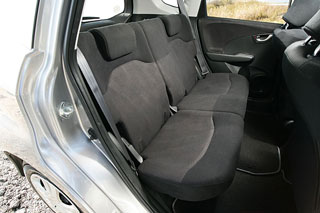 But here you should keep in mind this. On the Fit RS machine, the rotation frequency of the crankshaft, at which the switching for increased gear is necessarily, is determined exactly, and as for the Demio Sport transmission settings, then another factor is taken into account how much the gas pedal is filed. In other words, the moment of the transition can be slightly delayed or vice versa, slightly accelerated. And if in the first case everything is clear, then in the case of Demio everything is not so unambiguous. At least for the short time that was allocated to test this car, situations arose several times when it was difficult for me to catch the rhythm of its movement. For example, I remember exactly: in this section Fit RS first went to the 2nd, then at the 3rd speed. Then I transplant to Demio Sport, whose transfer numbers lower, and try to go through this place at the same pace. And suddenly I see that after the 2nd and 3rd speed he demands to switch to the 4th gear. And this happened more than once: you think that you will go through a turn of two or three doses, and suddenly in the middle of the turn it turns out that the transmission is required to cross one step higher. To avoid this, you need to understand the logic of switching in order to enable increased speed at the right time.
But here you should keep in mind this. On the Fit RS machine, the rotation frequency of the crankshaft, at which the switching for increased gear is necessarily, is determined exactly, and as for the Demio Sport transmission settings, then another factor is taken into account how much the gas pedal is filed. In other words, the moment of the transition can be slightly delayed or vice versa, slightly accelerated. And if in the first case everything is clear, then in the case of Demio everything is not so unambiguous. At least for the short time that was allocated to test this car, situations arose several times when it was difficult for me to catch the rhythm of its movement. For example, I remember exactly: in this section Fit RS first went to the 2nd, then at the 3rd speed. Then I transplant to Demio Sport, whose transfer numbers lower, and try to go through this place at the same pace. And suddenly I see that after the 2nd and 3rd speed he demands to switch to the 4th gear. And this happened more than once: you think that you will go through a turn of two or three doses, and suddenly in the middle of the turn it turns out that the transmission is required to cross one step higher. To avoid this, you need to understand the logic of switching in order to enable increased speed at the right time. What is more important: a similar product for less money or the opportunity to subtly feel the car?
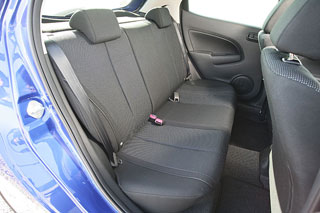 If you carefully study the list of equipment that is on Fit RS and Demio Sport, and then compare the sales price of one and the second car, it turns out that Mazda requests a little less for a similar product set than Honda. But, I think, to evaluate the car only by what is written on paper is wrong, since this approach does not take into account how the car drives. So, before finally solving such a price equation, you need to get behind the wheel and try both cars in business. And then I do not exclude that Fit RS, albeit not much, but still will outplay his competitor. Why? Well, firstly, the body, which, despite the apparent resemblance to the machine of the former generation, actually became much tougher. Then, the good work of the suspension, which in any situation provides the machine with a well -known supply of stability. Plus, the possibility of a powerful spurt, and regardless of the initial speed of movement. What else? Oh yes, an amazingly spacious salon, inside of which there are solid seats made by the driver and passengers, made by the Drivers Seat type (that is, categories for everyday drive). No, however, if you approach the car as an ordinary product that should have a certain used value, then Fit RS is just that product, if there are flaws, then there are very few of them.
If you carefully study the list of equipment that is on Fit RS and Demio Sport, and then compare the sales price of one and the second car, it turns out that Mazda requests a little less for a similar product set than Honda. But, I think, to evaluate the car only by what is written on paper is wrong, since this approach does not take into account how the car drives. So, before finally solving such a price equation, you need to get behind the wheel and try both cars in business. And then I do not exclude that Fit RS, albeit not much, but still will outplay his competitor. Why? Well, firstly, the body, which, despite the apparent resemblance to the machine of the former generation, actually became much tougher. Then, the good work of the suspension, which in any situation provides the machine with a well -known supply of stability. Plus, the possibility of a powerful spurt, and regardless of the initial speed of movement. What else? Oh yes, an amazingly spacious salon, inside of which there are solid seats made by the driver and passengers, made by the Drivers Seat type (that is, categories for everyday drive). No, however, if you approach the car as an ordinary product that should have a certain used value, then Fit RS is just that product, if there are flaws, then there are very few of them. And yet, no matter how strange it will seem, in which case I would have stopped my choice precisely on Demio. Of course, if it was a dispute of just two different models of a 1.3-liter class, in which Demio Sport would not take part, I probably would also choose something from the FIT lineup. But since the question is the edge of either Demio Sport or Fit RS, I take the courage to answer: for me only Sport!.
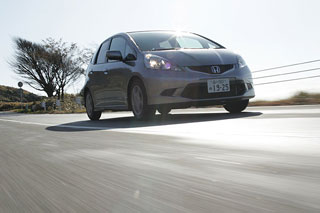 What is he good?, You ask. I answer: as it seemed to me, sitting behind the wheel of Demio Sport, you feel much better. In fact, if you are twisting the steering wheel, understanding perfectly how the clutch with the road of each of the 4 wheels participating in the movement changes, then you are calm, at least until the wheels have a reliable contact with the roadbed . And if, in addition, the car is slightly loaded, then even on the turn of the wheels they are trying in every possible way not to lose this very contact with the ground, but on the contrary, they are still clinging to the ground and try to run exactly along their path. You can only be surprised at what accuracy and even dashing the car you controls you describes the trajectory you planned. True, if you compare the behavior of the rear wheels Fit and Demio, it should be admitted: the former hold on to the road much stronger, so the back of the car shows simply enviable stability. At the same time, Demio Sport also largely overcame the disease of all the previous front -wheel drive machines of this lineup, which I would call rampant wagging backwards. No, Demio Sport in this regard is much more restrained, and if the driver knows how to analyze the information coming from each wheel (I repeat, it is amazingly accurate and complete), then he will not be difficult to understand what is possible and what, excuse me, is no longer, because You can break into the yuz. It would be generally remarkable if the machine had a special system for ensuring sustainability, but since not, then it is not necessary!
What is he good?, You ask. I answer: as it seemed to me, sitting behind the wheel of Demio Sport, you feel much better. In fact, if you are twisting the steering wheel, understanding perfectly how the clutch with the road of each of the 4 wheels participating in the movement changes, then you are calm, at least until the wheels have a reliable contact with the roadbed . And if, in addition, the car is slightly loaded, then even on the turn of the wheels they are trying in every possible way not to lose this very contact with the ground, but on the contrary, they are still clinging to the ground and try to run exactly along their path. You can only be surprised at what accuracy and even dashing the car you controls you describes the trajectory you planned. True, if you compare the behavior of the rear wheels Fit and Demio, it should be admitted: the former hold on to the road much stronger, so the back of the car shows simply enviable stability. At the same time, Demio Sport also largely overcame the disease of all the previous front -wheel drive machines of this lineup, which I would call rampant wagging backwards. No, Demio Sport in this regard is much more restrained, and if the driver knows how to analyze the information coming from each wheel (I repeat, it is amazingly accurate and complete), then he will not be difficult to understand what is possible and what, excuse me, is no longer, because You can break into the yuz. It would be generally remarkable if the machine had a special system for ensuring sustainability, but since not, then it is not necessary! 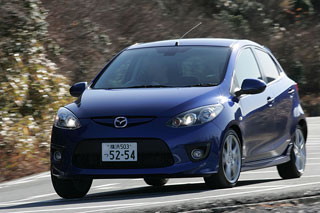 Oh, yes, I agree that the FIT car suspension acts in the most impeccable way: on the one hand, it provides the machine with a stability supply, and on the other, it does it unobtrusively so that the driver believes that everything depends only on his skill and desire. But still, I take the courage to say that at least the one that is equipped with 15-inch wheels (and I had to try out FIT on such rubber), accurate information about how durable the contact of the wheels from Dear, the driver does not work. And besides, the FIT car with all its lightness, the steering amplifier is configured for smooth operation. In this regard, I believe that the Demio Sport car with its instant reaction to steering teams among true sports driving lovers will deserve a higher assessment. The brakes of both cars for their class are quite cool (may this involuntary pun for me!), But in order to control them with greater accuracy, you should drive Demio, and only then you will understand how the finish brake should act.
Oh, yes, I agree that the FIT car suspension acts in the most impeccable way: on the one hand, it provides the machine with a stability supply, and on the other, it does it unobtrusively so that the driver believes that everything depends only on his skill and desire. But still, I take the courage to say that at least the one that is equipped with 15-inch wheels (and I had to try out FIT on such rubber), accurate information about how durable the contact of the wheels from Dear, the driver does not work. And besides, the FIT car with all its lightness, the steering amplifier is configured for smooth operation. In this regard, I believe that the Demio Sport car with its instant reaction to steering teams among true sports driving lovers will deserve a higher assessment. The brakes of both cars for their class are quite cool (may this involuntary pun for me!), But in order to control them with greater accuracy, you should drive Demio, and only then you will understand how the finish brake should act. However, in fairness, it is worth noting that the verdict I have made can still not be considered final. The fact is that, as I have already explained, this time cars with unavailable transmissions CVT were offered for comparison. But I do not exclude that if cars with 5-speed mechanical boxes participated in this improvised duel, the results could be completely different. Why do I think so? Well, if only because the manual Fit RS is standardly equipped with 16-inch tires, and this, in particular, can turn into the fact that the driver can better feel how the wheels cling to the road. Plus, and the reaction of the car to the commands going from the steering wheel may also seem different if a 5-speed manual speed box is valid instead of CVT. On the other hand, the DEMIO car will be deprived of the shortcomings in the transmission that make itself felt in the case of a variator in the manual switching mode, as mentioned earlier. Perhaps the complete or even partial solution to this problem has led to the fact that Demio Sport could record extra points in his asset. In a word, we, Car View employees, make an offer: next time to arrange a meeting between the same participants in Demio Sport and Fit RS, but only armed with 5-speed manual gearboxes. And then let's see whose will take!
Technical characteristics of the Honda Fit RS car
Full length: 3 920 mm.
Full width: 1 695 mm.
Complete height: 1 525 mm.
Wheel base: 2 500 mm.
Machine weight: 1 080 kg.
Drive: on the front wheels.
Engine: 1.5-liter, 4-cylinder with in-line cylinders, the SOCH gas distribution mechanism, developed power 88 kW (120 hp) at 6,600 rpm, the largest torque 145 nm (14.8 kg-m (14.8 kg-m ) at 4 800 rpm.
Transmission: a stranded variator with a 7-speed manual switching mode.
The basic price of the machine: 1 million 575 thousand yen ($ 14,625).
Technical characteristics of the car Mazda Demio Sport
Full length: 3 895 mm.
Full width: 1 695 mm.
Complete height: 1,475 mm.
Wheel base: 2490 mm.
Machine weight: 1020 kg.
Drive: on the front wheels.
Engine: 1.5-liter, 4-cylinder with a vertical cylinder arrangement, DOCH gas distribution mechanism, developed capacity of 83 kW (113 hp) at 6,600 rpm, the largest torque 140 nm (14.3 kg -M) at 4,000 rpm.
Transmission: a stranded variator with a 7-speed manual switching mode.
The basic price of the machine: 1 million 580 thousand yen ($ 14,670).
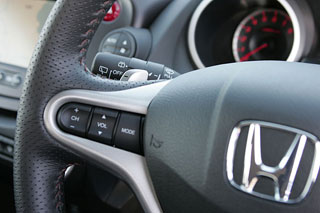
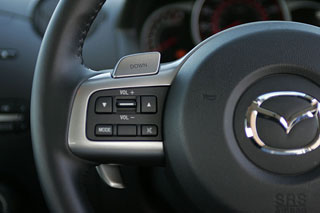
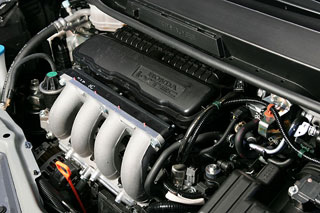
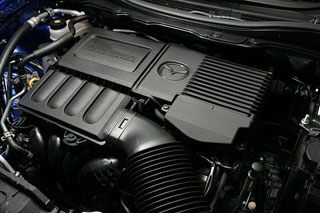
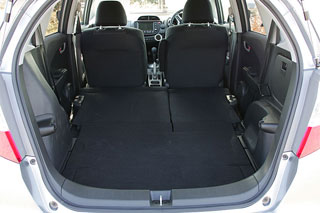
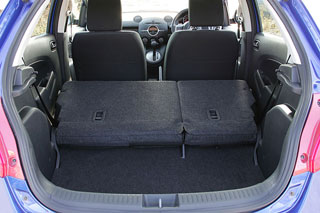
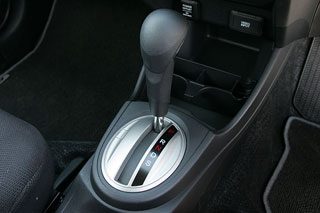
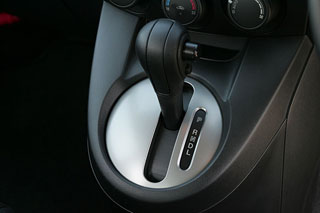
Source: CarView.co.jp




